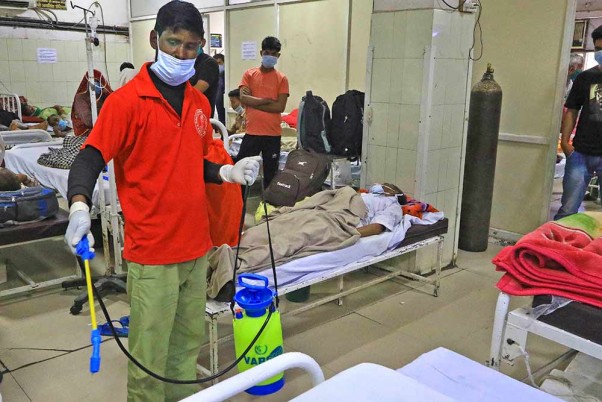Santosh Kumar Mohapatra
With the number of Covid-19 victims rising exponentially, it is vital to assess where India stands in terms of medical capacity to provide the necessary healthcare. India’s poor health infrastructure belies any hope, and the health sector is in the doldrums. The nation ranked low at 145th among 195 countries in terms of healthcare access and quality, as per recent global assessments.
To start with, the doctor-population ratio. Here, it is 1:1456 against the WHO recommendation of 1:1000. This means, for a 1,000 population, India has only 0.9 doctors as against the world average of 1.6. India is behind China with 2 doctors and Pakistan and Sri Lanka one doctor each for a 1,000 population. If the number of government beds in India is considered, it was 0.7 per 1,000 population in 2011, which has declined to 0.58 in 2015 and further to 0.53 in 2017 — as against a world average of 2.7.
Dismal health expenditure figures have triggered massive pressure on the existing health infrastructure, which is further enfeebled in the aftermath of Covid-19. As per a World Bank report in 2017, India’s total healthcare spending was 3.53 per cent of the GDP, much lower than world average of 9.896 percent. However, public expenditure/government spending on healthcare as a percentage of GDP is a better index of the health-welfare of a people than the total health expenditure as a percentage of the GDP. On this count, India’s performance is even more abysmal. Of the total public health expenditure, the Centre’s share is 25 per cent.
The National Health Policy 2017 had recommended that the government’s spending in health sector should be 2.5 per cent of the GDP by 2025. But, it is still ranging from 1 per cent to 1.29 per cent. India’s public expenditure on health as a percentage of the GDP is far lower than those of the poorest countries. India occupies the 170th position out of 188 countries in terms of public health expenditure.
As per World Bank data in 2017, India’s public health expenditure as a proportion of GDP is 0.96 percent against a world average of 5.89 per cent. India spends even lower than that of Bhutan with 2.37 percent, Sri Lanka 1.64 percent, and Nepal 1.24 percent.
In terms of per capita health expenditure per year, as of 2017, India’s $69.29 per cent is too low when compared to world average of $1061.14. According to the National Health Profile of 2018, the public per capita expenditure on health increased from Rs 621 in 2009-10 to Rs 1,112 in 2015-16. That comes to Rs 93 per month or Rs three per day. Sri Lanka spends about four times as much. Question is: how people can cope with Covid-19, with a mere Rs 3 per day?
According to a WHO report, the total health spending is growing faster than the GDP in low and middle income countries (close to 6 per cent on average) than in high income countries (4 per cent). Health system resources are coming less from households paying out of pocket and more through pooled funds, in particular from domestic government sources. But, in India, this is declining.
India’s health sector is the most privatized in the world. As out-of-pocket expenditure proportionate to total health expenditure in 2017, Indians spent 62.10 percent on health, compared to a world average of 18.207.According to National Health Profile data, the cost of treatment has been on the rise in India, which has led to inequity in access to healthcare. National Crime Records Bureau (NCRB) says that, troubled by illness, 3.85 lakh people committed suicide between 2001 and 2015.
The countries that have emerged as developed in course of time have seen increased expenditure in health as a percentage of GDP. Cuba spends 11.71 per cent of the GDP in health; with 10.47 per cent of the GDP being public health expenditure –the highest in the world. Cuba has 8.4 doctors per 1000 population, with 5.2 government beds for a 1,000 population.
Without increasing health care expenditure, relying on the health insurance route alone will serve no purpose. If the government invests more on health or provide health facilities to people at cheaper rates, they will have more income at disposal to spend. With the rise in discretionary spending, demand will rise, leading to an increase in economic activities and thereby faster growth and development.
The writer is an Odisha-based economist.

